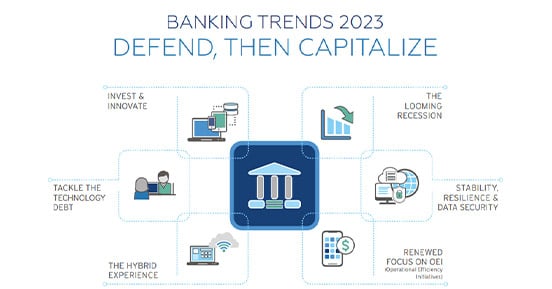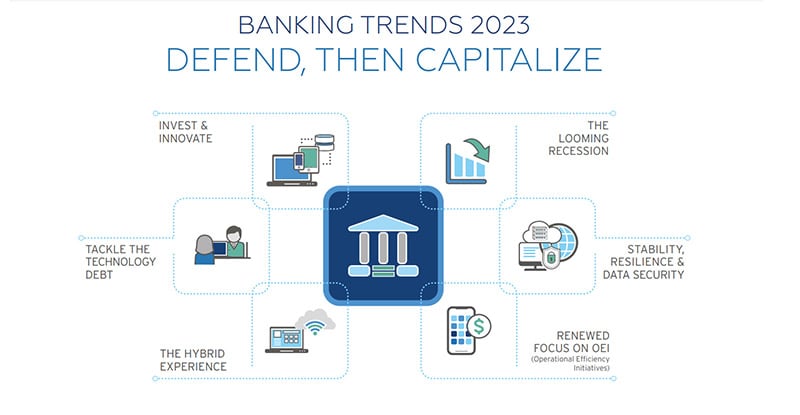Elevate the power of your work
Get a FREE consultation today!
Current economic headwinds create new pressures on banks, so stability and resilience are essential

Current economic headwinds create new pressures on banks, so stability and resilience are essential. However, innovation and digital transformation must be priorities for banks to deliver customer value and remain competitive. We’ve reviewed predictions and perspectives from the experts to share key themes around banking industry challenges for 2023.
Interest rates and inflation are high, and consumer demand is slowing. Economists say there’s a 7 in 10 chance the U.S. will see a recession in 2023. Yet, while battening down the hatches and waiting for the storm to pass, forward-thinking banks need to invest in innovation to be prepared for when the economy turns around. Banks should explore new sources of value beyond the current thinking.
It’s important for banks to prioritize operational efficiency and cost control. “Process miners” will be seen as heroes for banks as they focus on operational efficiency and effectiveness initiatives.
“Cost-cutting has become a priority for 73% of financial services firms.”
During the pandemic, customer experience (CX) was transformed to involve more digital and hybrid interactions. Customers now demand digital services and have high expectations.
Adopting advanced technologies can be a way to gain greater operational efficiencies and maintain a competitive advantage. Digital inertia and a lack of technology investment will come at a cost to banking organizations.
Everyone is looking ahead to the digital end game, and banks are realizing that digital transformation has the ability to unlock cost savings and business value. Banks have plenty of data, but they often lack the means to derive value from it. Accelerated digital transformation gives banks the tools to transform the foundations of banking.
Banks are facing resource constraints including loss of productivity due to attrition among existing talent and challenges in recruiting new talent. They are now prioritizing more conservative objectives — customer experience (CX), operations excellence and new products/services — above revenue growth. Initiatives around operational efficiency and effectiveness are a priority.
We help clients streamline their banking operations—reducing costs and keeping customers secure
Achieving operational efficiencies while delivering an outstanding customer experience continue to be key business goals impacting the 72,000 open U.S. bank branches.
Get a FREE consultation today!
“Cost-cutting has become a priority for 73% of financial services firms.”
During the pandemic, customer experience (CX) was transformed to involve more digital and hybrid interactions. Customers now demand digital services and have high expectations.
Adopting advanced technologies can be a way to gain greater operational efficiencies and maintain a competitive advantage. Digital inertia and a lack of technology investment will come at a cost to banking organizations.
Everyone is looking ahead to the digital end game, and banks are realizing that digital transformation has the ability to unlock cost savings and business value. Banks have plenty of data, but they often lack the means to derive value from it. Accelerated digital transformation gives banks the tools to transform the foundations of banking.
Banks are facing resource constraints including loss of productivity due to attrition among existing talent and challenges in recruiting new talent. They are now prioritizing more conservative objectives — customer experience (CX), operations excellence and new products/services — above revenue growth. Initiatives around operational efficiency and effectiveness are a priority.
“Prepare to help banks to implement their digital enterprise vision.”
We believe the trends discussed above will drive banking organizations’ decision-making in 2023 — either operationally, investment-wise or architecturally.
One overarching, holistic theme for banks this year is the drive to net zero. This is not only in terms of sustainability and carbon footprint, but also in terms of reducing an organization’s footprint in the areas of real estate, physical assets, processes and technology debt. Bank branches are closing, and physical assets, including IT assets, will be reduced. Processes are being streamlined and modernized, including adopting an agile approach. Banks must eliminate outdated technologies and modernize legacy architecture. Finally, environmental, social and governance (ESG) has become a business imperative, and banks are under pressure to meet their goals. These include reducing environmental greenhouse gasses, achieving net zero carbon usage, and demonstrating tangible results.

At Iron Mountain, we work with customers who span retail, commercial and wealth management banking. In fact, 2,500 financial services institutions worldwide work with Iron Mountain. Here’s a closer look at how different subsectors within the banking industry will face the challenges of 2023.
In general, banks are facing 2023 in a position of relative strength. Capital buffers are strong, and liquidity is adequate. As a result, due to higher net interest income from rising rates, retail banking should fare well in 2023. However, investment banking performance will probably be mixed due to languishing underwriting and M&A advisory activities.
We believe banks will renew their focus on operational efficiency and effectiveness initiatives to maintain stability and resilience in 2023. At the same time, they’ll sustain a focus on innovation — including digital transformation — so they don’t fall behind.
Ultimately, by 2027, 93% of managers, directors and executives have a goal to eliminate paper records, according to a research survey commissioned by Iron Mountain. Clean-up of paper records cuts costs and risk, while opening the door to reveal new value from digital information. Digital transformation will be essential as the banking industry evolves and services customers.
Iron Mountain can help banking institutions achieve the following outcomes to fulfill their goals.
Explore all Iron Mountain Banking Solutions.


Enter your information to access the full content.